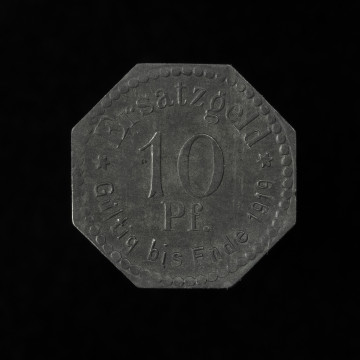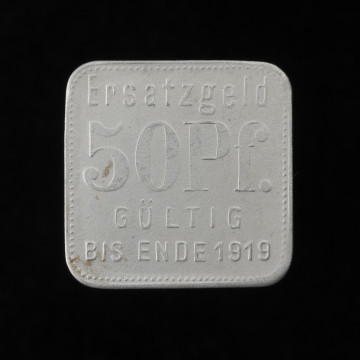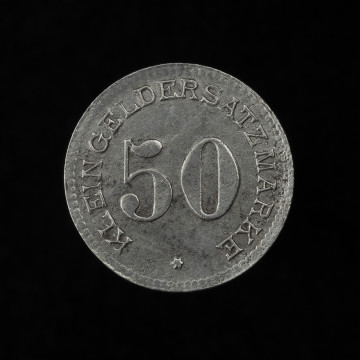
10 pfennig
1917
National Museum in Szczecin
Part of the collection: Scrip
The collection of bullion money by the Reichsbank on the eve of the First World War and the salvaging of coins by the public caused retail payment difficulties in Germany. Local authorities decided to remedy this problem by starting to mint their own replacement coins. The city of Szczecin followed suite to address the shortage of small coinage in circulation. During the First World War, the city council decided to issue replacement metal money. In 1917, octagonal coins of 5 and 10 pfennig were commissioned to be minted in zinc, in 1918 50 pfennig square coins were minted in iron, and in 1920 the 5, 10 and 50 pfennig denominations were minted in zinc in the shape of a thirteen-petal rosette. The 1917 and 1920 issues were probably manufactured by L. Chr. Lauer of Nuremberg. Virtually all of the aforementioned coins can be found in multiple varieties, reflecting high demand and their mass production. They were frequently given an unconventional design. The 1920 issue is particularly interesting, as very few rosette-shaped coin designs were created. On the reverse, alongside the denomination and the information that the user is handling replacement money, the expiry date of the coin, being the end of 1922, was stated. After this date, they had no right to remain in circulation and had to be redeemed by the city for official means of payment. As soon as the replacement money started to be issued, it started to be collected as well. This is why many coins did not return to the issuers' coffers, but instead contributed to collectors' holdings, and some issues were even created with collectors in mind, never coming into circulation. Mieszko Pawłowski
Other names
50 Pfennig, Notgeld
Author / creator
Object type
token coin
Technique
coining
Material
zinc
Origin / acquisition method
donation
Creation time / dating
Creation / finding place
Owner
Muzeum Narodowe w Szczecinie (1945- )
Identification number
Location / status

1917
National Museum in Szczecin

1918
National Museum in Szczecin

1901 — 1925
National Museum in Szczecin
DISCOVER this TOPIC
National Museum in Lublin
DISCOVER this PATH
Educational path